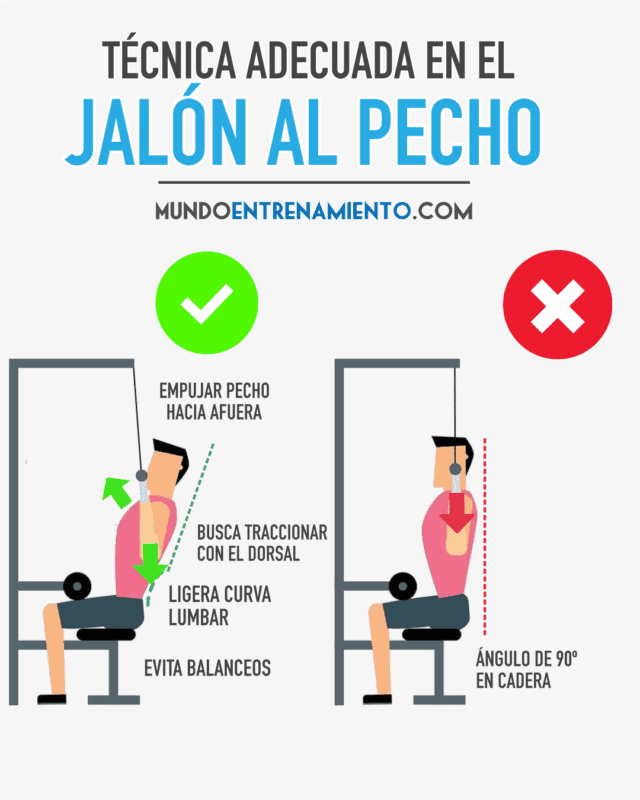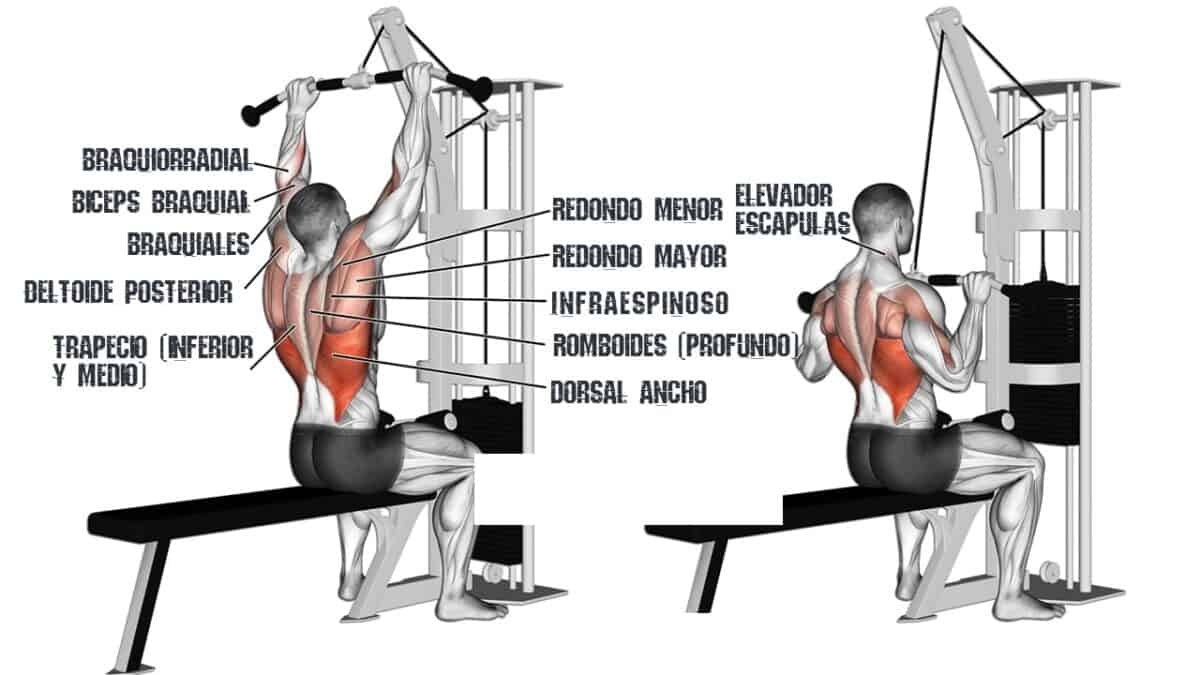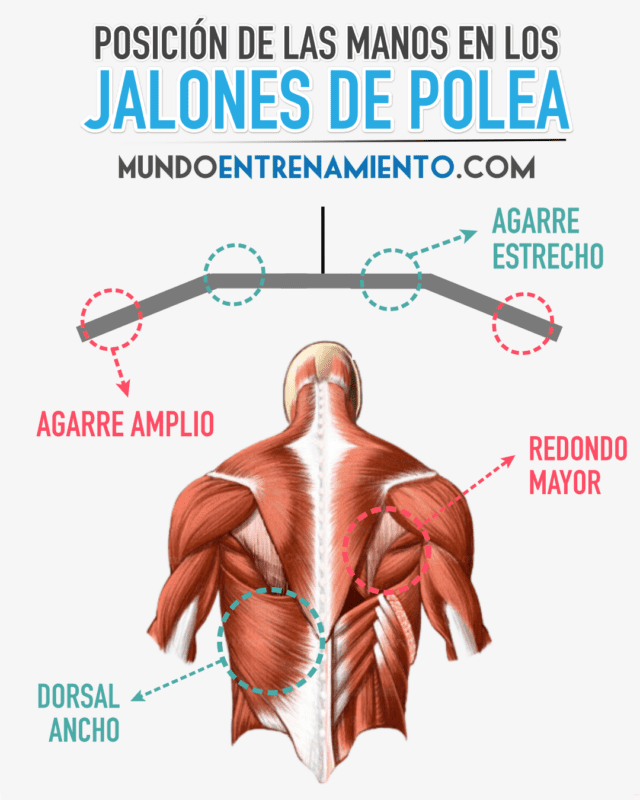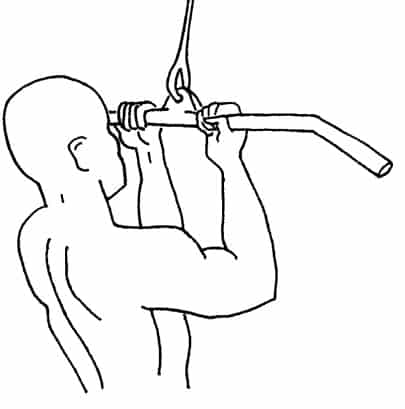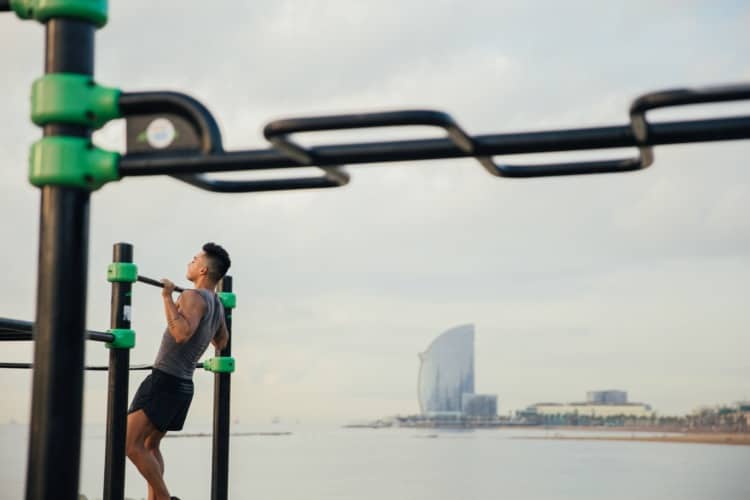In the following article, we analyze in depth the lat pulldown, one of the most commonly used exercises in fitness rooms to work the upper body muscles.
The lat pulldown is a vertical pulling exercise for which there are many guided machines and variations.
Due to its muscle involvement and the ease of using the machines, it is an exercise included in weight loss, hypertrophy, strength improvement, injury rehabilitation programs, etc.
What is the lat pulldown?
The lat pulldown is an open kinetic chain, multi-joint, and vertical pulling exercise, “one of the movement patterns of the human body” (1).
The movement requires arm flexion to bring the bar towards the body, thus performing a pulling movement that activates different muscle groups.
In addition to lat pulldown machines, the exercise can be performed with adjustable pulleys, elastic bands, etc. (1)
How to do the lat pulldown?
The movements performed in the lat pulldown can be divided into the following phases (1,2):
Pre-adjustments
In lat pulldown machines, the height of the leg pads must be adjusted so that they are secured and bent around 90º.
Their main function is to prevent the lower body from lifting or sliding on the seat during the exercise.
Additionally, we will have to adjust the weight with which we will perform the established sets and repetitions.
Initial position
- The legs are bent at 90º and secured by the pads.
- The bar is gripped with the hands with a width greater than shoulder-width.
- The hands are placed with a pronated grip (palms facing forward).
- Before starting to pull, the body leans slightly backward to maintain an angle approximately between 70 and 80º from the vertical and in a neutral position. This position reduces the risk of shoulder impingement (2).
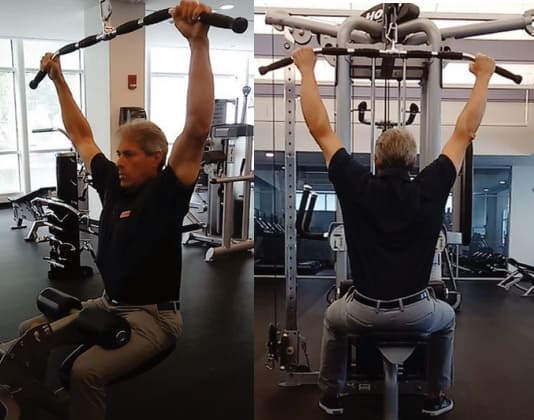
Pull (concentric phase)
- The arms flex, pulling the bar down in front of the body.
- The elbows are directed backward and downward during the descent of the bar while the chest goes outward. Consequently, the scapulae retract, meaning they come together as the bar approaches the body.
- The bar is lowered to the chest or clavicular area.
- The body remains in a neutral position with the initial inclination.
- The instructions that can be given to the person to achieve all this are: ‘tuck the chin slightly’, ‘look forward’, ‘keep the head and torso still in each repetition’, and ‘keep the shoulders down, away from the ears’.
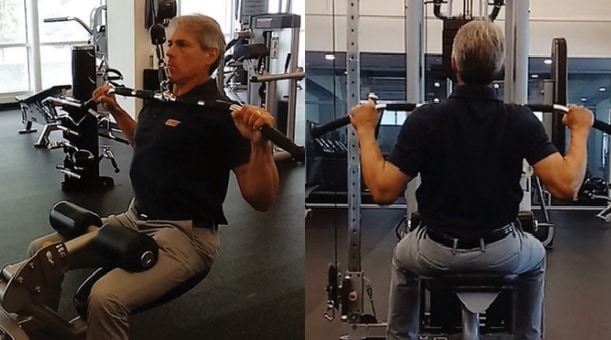
Return to the initial position (eccentric phase)
- Perform the return path by extending the arms while keeping the bar under control.
- The shoulders maintain stability during the return path (shoulders down).
- The body remains slightly inclined backward and the head still.
- ‘Keep the shoulders down’ or ‘return to the starting position smoothly and controlled until fully extending the elbows’ are useful instructions that can be given to the performer to facilitate execution.
Common mistakes when performing the lat pulldown
The following technical errors are common when performing this exercise:
- Excessive trunk inclination; the body must be maintained at an angle between 70-80º with respect to the vertical.
- Not bringing the elbows back or retracting the scapulae.
- Raising the shoulders during the return path. It is necessary to maintain shoulder stability during the return to the initial position.
- Moving the body during the pull. The body must remain still in both the concentric and eccentric phases.
What muscles are worked in the lat pulldown?
The lat pulldown is a multi-joint exercise that involves a large number of upper body muscles.
The main muscles that are activated concentrically and/or eccentrically during the movement are (1):
- Latissimus dorsi
- Teres major
- Deltoid
- Pectoralis major
- Infraspinatus
- Subscapularis
- Rhomboids
- Middle and lower trapezius
- Biceps brachii
- Hand flexors
The ‘standard’ lat pulldown is considered to be performed with a pronated grip and with the hands at a width greater than shoulder-width.
JE Signorile et al. (2002) concluded in their study on the lat pulldown that performed in a ‘standard’ way was the one that most activated the latissimus dorsi and teres major compared to other grip types (3).
SJ Lusk et al. (2010) also reached the same conclusion after analyzing the pulldown with different widths and grips.
On this occasion, they found that the latissimus dorsi is more activated with a pronated grip whether wide or narrow than with other grips (4).
However, this exercise can be performed with different grips and widths:
- With a supinated grip
- With a pronated grip and narrow grip (modified standard)
- With a neutral grip
Lat pulldown with supination
This variation of the pulldown is performed with a supinated grip and with a separation of the hands at shoulder height.
JE Signorile et al. (2002) analyzed this grip comparing it with a pronated grip, with the triangle bar, and performed posteriorly (behind the neck).
The authors found no significant differences when performed in supination compared to other grips in the latissimus dorsi, pectoralis major, posterior deltoid, teres major, and long head of the triceps (3).
SJ Lusk et al. (2010) studied the differences in muscle activation of the biceps brachii, latissimus dorsi, and middle trapezius with wide, narrow, pronated, and supinated grips.
The authors concluded that there were no significant differences in any of the 3 muscles analyzed performed in supination compared to other grips (4).
En este curso vamos a tratar el entrenamiento de la fuerza orientada a la hipertrofia muscular, buscando las formas de optimizar el proceso a la hora de planificar las cargas y las sesiones de entrenamiento.
Aprenderemos a determinar cuándo nos interesa conseguir esa hipertrofia, cómo esta afecta a los niveles de fuerza y la importancia de conocer el estado inicial de la persona que se someta a este tipo de entrenamiento.
Lat pulldown with pronated and narrow grip
This technical variant modifies the standard pulldown by performing it with a narrower grip.
V Andersen et al. (2014) investigated different widths (wide, medium, and narrow grip) in muscle activation of the exercise.
The results showed a greater activation of the biceps brachii with a medium grip compared to wide or narrow (4).
Lat pulldown with neutral grip
To perform this variant, it is necessary to replace the bar with a specific triangle grip. This accessory allows performing the pull with a neutral wrist grip.
JE Signorile et al. (2002) concluded that performing it neutrally increases the activation of the pectoralis major and posterior deltoid (3).
Lat pulldown behind the neck or to the chest?
The lat pulldown behind the neck is the exercise variant that consists of bringing the bar behind the head.
The lat pulldown behind the neck has always been associated with greater activation of the latissimus dorsi compared to the one performed to the chest.
The absence of scientific evidence caused the pulldown exercise to be performed behind the neck and not to the chest in the past.
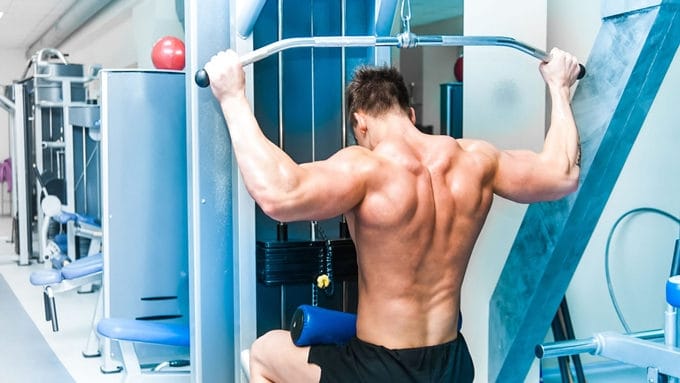
JE Signorile et al. (2002) found that all the muscles analyzed (latissimus dorsi, pectoralis major, posterior deltoid, long head of the triceps, and teres major) had greater activation in the lat pulldown to the chest than performed behind the neck.
S Sperandei et al. (2009) compared the lat pulldowns to the chest and behind the neck concluding that the best option is the lat pulldown to the chest due to the better mechanics and not finding differences in muscle activation of the main muscles of the exercise (6).
In addition to not providing greater activation of the muscles involved in the lat pulldown behind the neck, this exercise causes a forced position of the shoulder joint that can cause impingements or friction between the bones that can lead to joint problems in the long term (7).
Lat pulldown vs pull-ups
The lat pulldown and pull-ups are the “most used exercises” to work the vertical pulling movement pattern.
I Löfquist (2017) investigated the differences in muscle activation in the latissimus dorsi, biceps brachii, trapezius, and rectus abdominis between pull-ups and the lat pulldown (8).
The results showed that there were no significant differences between doing pull-ups and the lat pulldown in muscle activation of the latissimus dorsi.
K Doma et al. (2013) also reached the same conclusion about the similar muscle activation of the latissimus dorsi between the lat pulldown and pull-ups (9).
Where there is controversy between both investigations is in the muscle activity of the biceps brachii in pull-ups compared to the pulldown, as one found greater activation (9) while the other found less activation (8).
Conclusions
The lat pulldown is one of the best exercises to work the back muscles.
Placing the hands in a pronated grip is the variant that most activates the latissimus dorsi.
The lat pulldown with a neutral grip increases the activation of the pectoralis major and posterior deltoid.
The lat pulldown behind the neck is discouraged as it presents no advantage compared to the one performed in front of the body.
No greater activation of the latissimus dorsi occurs and also the shoulder is placed in a forced position that can cause injuries.
The muscle activity of the latissimus dorsi is similar in the lat pulldown and in pull-ups.
The lat pulldown is one of the best exercises to work the back muscles.
Placing the hands in a pronated grip is the variant that most activates the latissimus dorsi.
View this post on Instagram
Bibliographic references
- Ronai, P. (2019). The Lat Pulldown. ACSM’s Health & Fitness Journal, 23(2), 24-30.
- Graham, J. F. (2003). Front lat pulldown. Strength & Conditioning Journal, 25(5), 42-43. “Link to the article”.
- SIGNORILE, J. E., Zink, A. J., & Szwed, S. P. (2002). A comparative electromyographical investigation of muscle utilization patterns using various hand positions during the lat pull-down. The Journal of Strength & Conditioning Research, 16(4), 539-546.
- Lusk, S. J., Hale, B. D., & Russell, D. M. (2010). Grip width and forearm orientation effects on muscle activity during the lat pull-down. The Journal of Strength & Conditioning Research, 24(7), 1895-1900.
- Andersen, V., Fimland, M. S., Wiik, E., Skoglund, A., & Saeterbakken, A. H. (2014). Effects of grip width on muscle strength and activation in the lat pull-down. The Journal of Strength & Conditioning Research, 28(4), 1135-1142.
- Sperandei, S., Barros, M. A., Silveira-Júnior, P. C., & Oliveira, C. G. (2009). Electromyographic analysis of three different types of lat pull-down. The Journal of Strength & Conditioning Research, 23(7), 2033-2038. “Link to the article”.
- Riek, L. M., Ludewig, P. M., & Nawoczenski, D. A. (2013). How “healthy” is circuit resistance training following paraplegia? Kinematic analysis associated with shoulder mechanical impingement risk. Journal of Rehabilitation Research & Development, 50(6).
- Löfquist, I. (2017). Differences in muscle activity during the chin-up versus lat pulldown exercise. An electromyographic study.
- Doma, K., Deakin, G. B., & Ness, K. F. (2013). Kinematic and electromyographic comparisons between chin-ups and lat-pull down exercises. Sports biomechanics, 12(3), 302-313.


